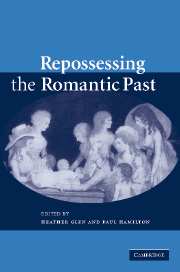Book contents
- Frontmatter
- Contents
- Notes on contributors
- Introduction
- PART I DISSENT AND OPPOSITION
- PART II REOPENING THE CASE OF EDGEWORTH
- PART III DIFFERENT DIRECTIONS
- 8 Coleridge's stamina
- 9 Elizabeth Hamilton's Translation of the Letters of a Hindoo Rajah and Romantic orientalism
- 10 Jane Austen and the professional wife
- 11 High instincts and real presences: two Romantic responses to the death of Beauty
- Marilyn Butler: a bibliography
- Index
11 - High instincts and real presences: two Romantic responses to the death of Beauty
Published online by Cambridge University Press: 15 December 2009
- Frontmatter
- Contents
- Notes on contributors
- Introduction
- PART I DISSENT AND OPPOSITION
- PART II REOPENING THE CASE OF EDGEWORTH
- PART III DIFFERENT DIRECTIONS
- 8 Coleridge's stamina
- 9 Elizabeth Hamilton's Translation of the Letters of a Hindoo Rajah and Romantic orientalism
- 10 Jane Austen and the professional wife
- 11 High instincts and real presences: two Romantic responses to the death of Beauty
- Marilyn Butler: a bibliography
- Index
Summary
Beauty is momentary in the mind –
The fitful tracing of a portal;
But in the flesh it is immortal.
(Wallace Stevens, ‘Peter Quince at the Clavier’)Few passages in twentieth-century poetry are better known than this. It reformulates the idea and ideal of Beauty in mortal rather than ideal terms. In this view, as Stevens also famously wrote, ‘Death is the mother of beauty’ because from death is born ‘the heavenly fellowship / Of men that perish and of summer morn’ (‘Sunday Morning’).
But are we confident of our confidence in these poetical formulations? Or let me ask the question another way: does Stevens's mortalist perspective on to kalon involve anything more than a stylistic flourish? Is Beauty immortal in the flesh? Do we agree with that, do we agree that Stevens actually means us to assent to that statement? To the idea being pronounced, presumably, by the statement? I ask these questions in order to clarify the full depth of the paradox involved here. For we would have to cognize in some fashion the truth of the statement that Beauty is immortal in the flesh. In that event our mortal, enfleshed minds would have not an immersion in some immortal Being of Beauty but only Beauty's fitful and momentary trace. For that is how our mortal minds work, according to this presentation on the matter.
- Type
- Chapter
- Information
- Repossessing the Romantic Past , pp. 226 - 243Publisher: Cambridge University PressPrint publication year: 2006
- 1
- Cited by

